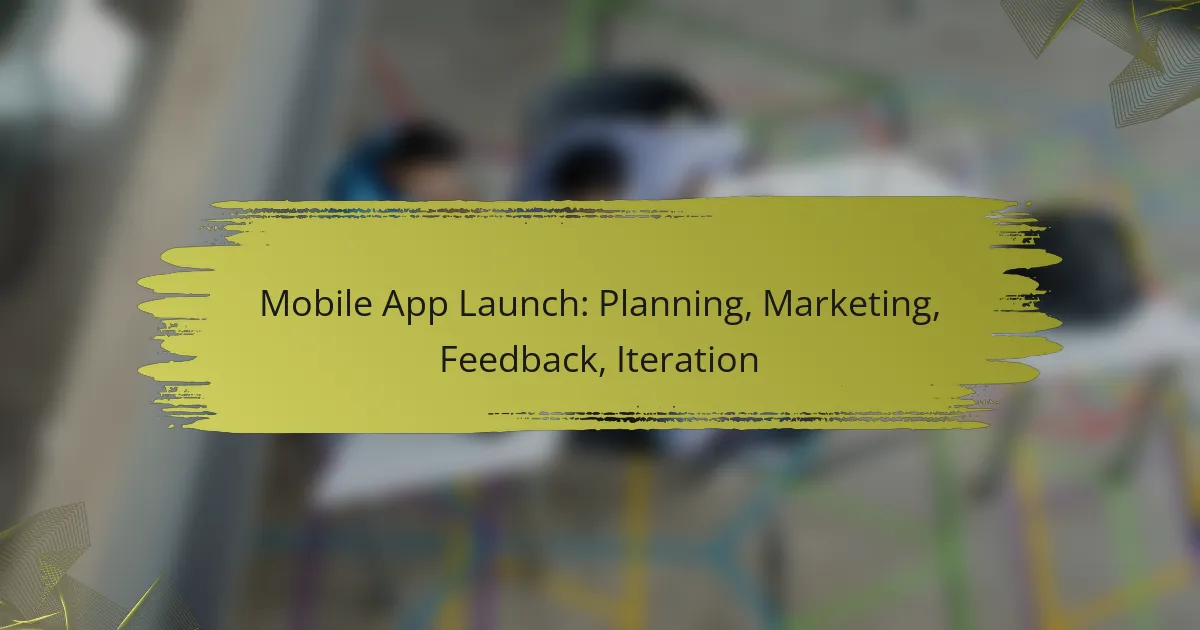Launching a mobile app requires meticulous planning and execution to ensure it resonates with the target audience and meets its objectives. This involves strategic preparation, effective marketing tactics, and a robust feedback loop to refine the app post-launch. By understanding user needs and leveraging various promotional channels, developers can maximize their app’s visibility and success in a competitive market.
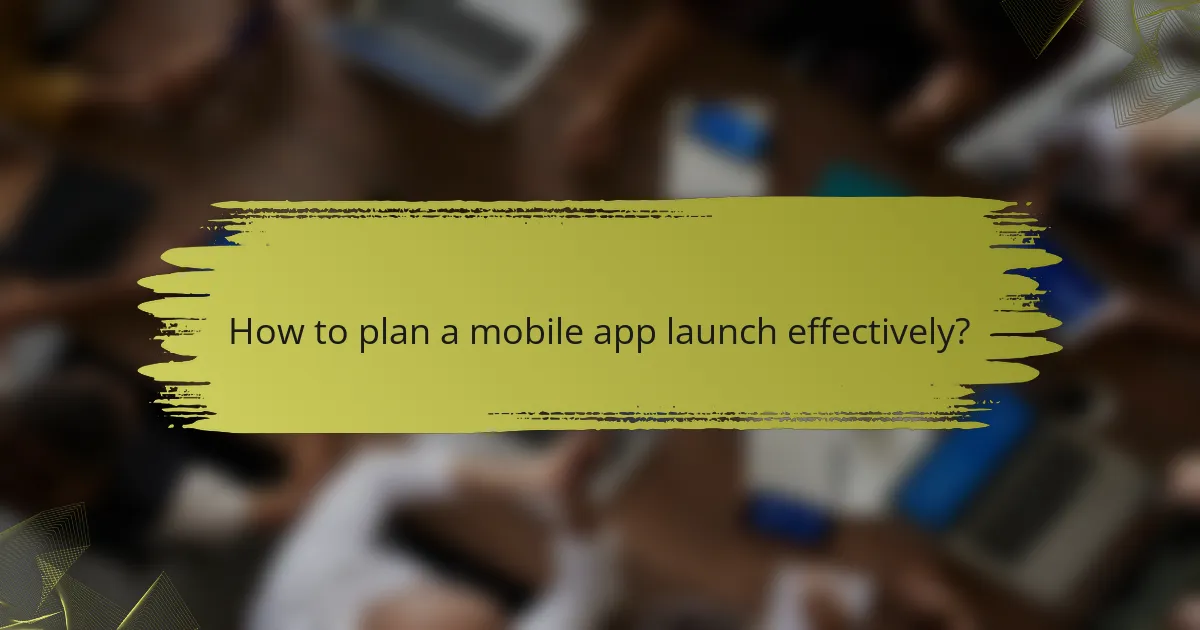
How to plan a mobile app launch effectively?
Planning a mobile app launch effectively involves strategic preparation across multiple dimensions, ensuring that your app reaches its intended audience and achieves its goals. Key elements include understanding your target audience, creating a timeline, setting clear objectives, allocating a budget, and conducting thorough market research.
Define target audience
Identifying your target audience is crucial for a successful app launch. Consider demographics such as age, gender, location, and interests to tailor your marketing efforts. Use surveys, social media insights, and analytics to gather data about potential users.
Once you have a clear picture of your audience, create user personas that represent different segments. This helps in crafting messages that resonate with each group, improving engagement and conversion rates.
Create a timeline
A well-structured timeline is essential for coordinating your launch activities. Start by outlining key milestones, such as development phases, beta testing, and marketing campaigns. Aim for a timeline that spans several months to allow for adjustments based on feedback.
Include buffer periods for unexpected delays and ensure that all team members are aware of their responsibilities. Regular check-ins can help keep the project on track and aligned with your launch goals.
Set clear goals
Establishing clear, measurable goals is vital for evaluating the success of your app launch. Goals might include user acquisition targets, engagement metrics, or revenue milestones. Use the SMART criteria—Specific, Measurable, Achievable, Relevant, Time-bound—to formulate these objectives.
Communicate these goals to your team to ensure everyone is aligned and understands the desired outcomes. This clarity will guide your marketing strategies and help in assessing performance post-launch.
Budget allocation
Effective budget allocation is key to maximizing your app launch’s impact. Determine how much you can invest in development, marketing, and post-launch support. A typical budget might allocate 20-30% for marketing, depending on your overall strategy.
Consider costs for advertising, promotional materials, and any partnerships. Regularly review your budget to ensure funds are being used efficiently and adjust as necessary based on performance metrics.
Market research
Conducting thorough market research helps you understand the competitive landscape and user needs. Analyze competitors’ apps to identify strengths and weaknesses, and gather insights on user preferences through surveys or focus groups.
Utilize tools like App Annie or Sensor Tower to track market trends and performance metrics. This information will inform your marketing strategy and help you position your app effectively within the market.
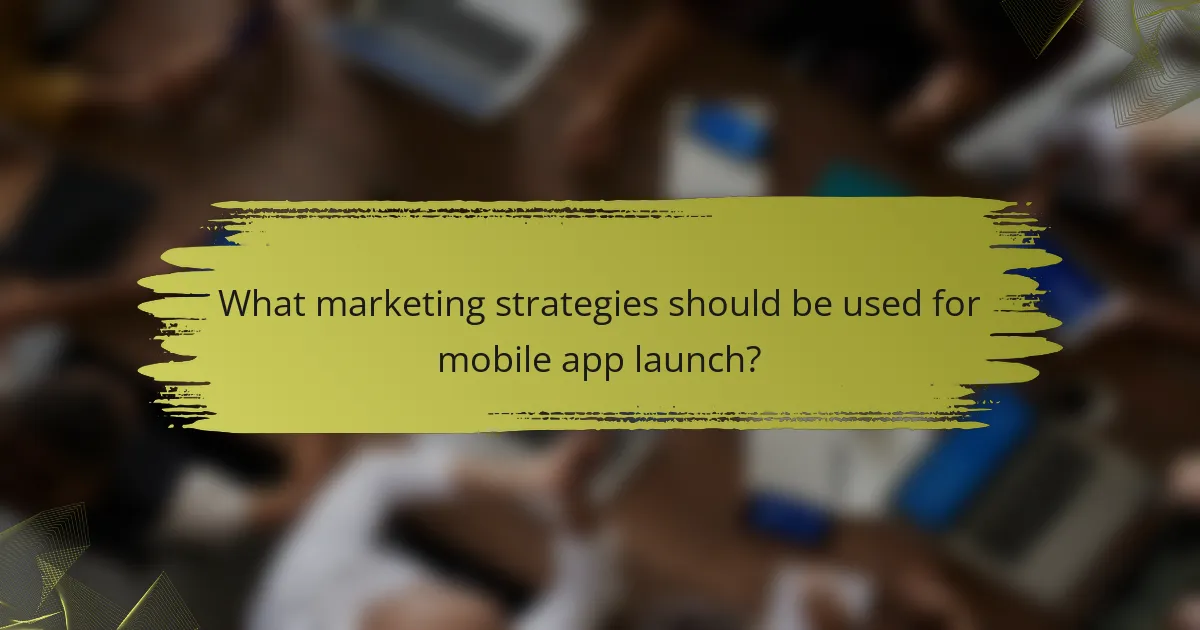
What marketing strategies should be used for mobile app launch?
Effective marketing strategies for a mobile app launch include leveraging social media advertising, forming influencer partnerships, executing email marketing campaigns, and implementing content marketing. Each strategy plays a crucial role in reaching the target audience and generating interest in the app.
Social media advertising
Social media advertising allows you to target specific demographics and interests, making it a powerful tool for app promotion. Platforms like Facebook, Instagram, and TikTok offer various ad formats, such as stories, carousel ads, and video ads, which can effectively showcase your app’s features.
Consider allocating a budget that allows for A/B testing different ads to see which resonates best with your audience. Aim for a mix of engaging visuals and clear calls to action to drive downloads.
Influencer partnerships
Partnering with influencers can significantly boost your app’s visibility. Choose influencers whose audience aligns with your target market to ensure authentic promotion. Micro-influencers, in particular, often have higher engagement rates and can be more cost-effective.
Provide influencers with access to your app and encourage them to share their genuine experiences. This approach not only builds trust but also encourages their followers to try your app.
Email marketing campaigns
Email marketing remains a valuable strategy for app launches, especially for reaching existing customers or subscribers. Create a series of emails that build anticipation leading up to the launch, highlighting key features and benefits of your app.
Segment your email list to tailor messages to different user groups, and include strong calls to action that direct recipients to download the app. Monitor open and click-through rates to optimize future campaigns.
Content marketing
Content marketing involves creating valuable content that attracts and engages your target audience. This can include blog posts, videos, and infographics that explain how to use your app or provide solutions to common problems it addresses.
Focus on SEO best practices to increase visibility in search engines. Share your content on social media and consider guest posting on relevant websites to expand your reach. Consistent, high-quality content can establish your brand as an authority in your niche and drive organic traffic to your app.
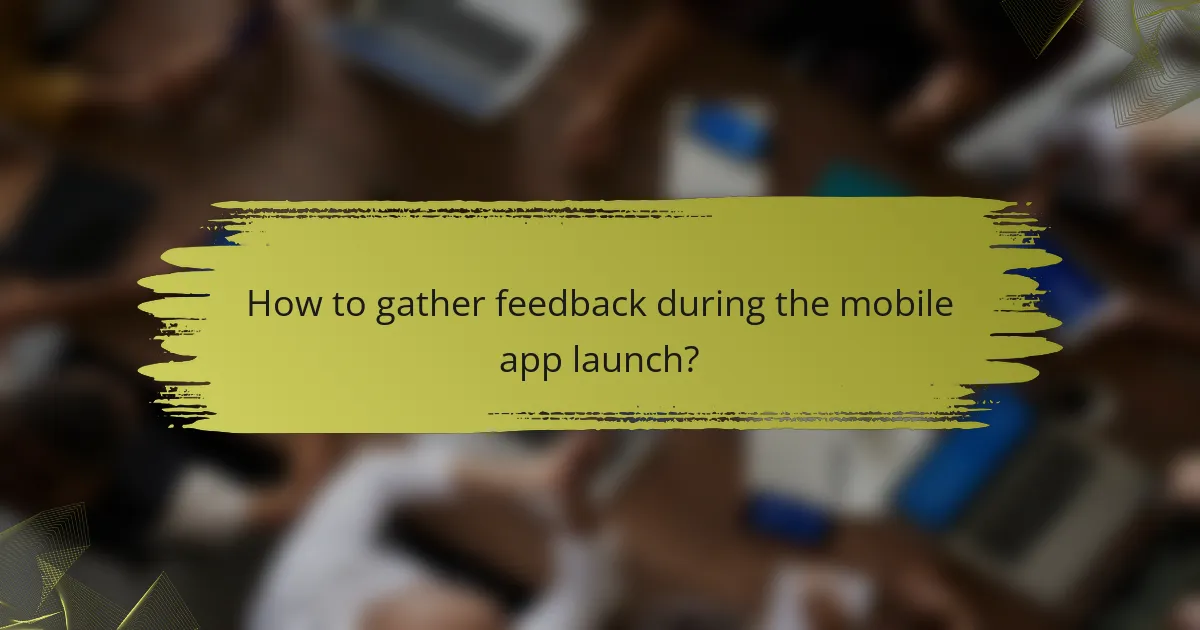
How to gather feedback during the mobile app launch?
Gathering feedback during a mobile app launch is crucial for understanding user experience and making necessary improvements. Effective methods include user surveys, in-app feedback tools, beta testing groups, and social media engagement.
User surveys
User surveys are a direct way to collect feedback from your audience. They can be distributed via email, social media, or within the app itself, and should focus on key aspects like usability, features, and overall satisfaction.
Keep surveys concise to encourage completion, ideally taking no more than 5 minutes. Use a mix of multiple-choice questions and open-ended responses to gather both quantitative and qualitative data.
In-app feedback tools
In-app feedback tools allow users to provide insights while they are actively using the app. These tools can include feedback buttons, pop-up prompts, or rating systems that capture user thoughts in real-time.
Consider implementing a simple rating system (e.g., 1 to 5 stars) along with an optional comment box. This approach helps identify immediate pain points and areas for enhancement as users navigate your app.
Beta testing groups
Beta testing groups consist of selected users who test the app before its official launch. This group can provide valuable insights into functionality, bugs, and user experience, helping you refine the app prior to a wider release.
Recruit a diverse group of testers that represents your target audience. Offer incentives, such as exclusive features or discounts, to encourage participation and honest feedback.
Social media engagement
Social media engagement is a powerful tool for gathering feedback during your app launch. Actively monitor platforms where your target audience interacts, and encourage users to share their experiences and suggestions.
Utilize polls, direct messages, and comment sections to solicit feedback. Responding promptly to user comments can foster a sense of community and encourage more users to share their thoughts.
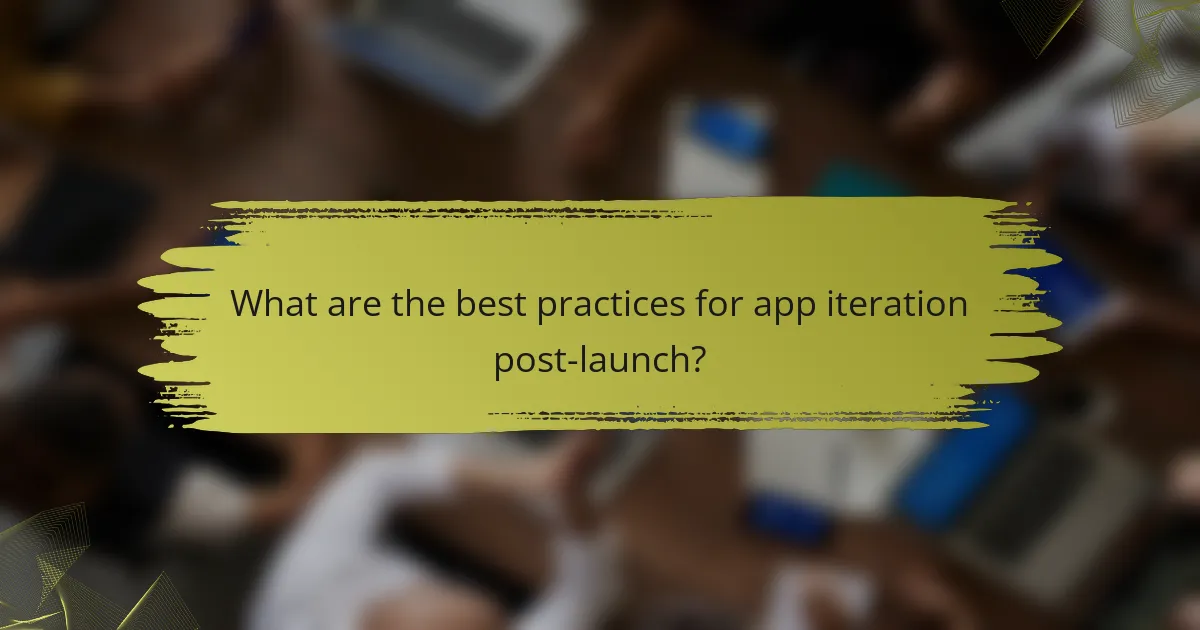
What are the best practices for app iteration post-launch?
Effective app iteration post-launch involves continuously improving the application based on user feedback and performance data. This process ensures that the app remains relevant, user-friendly, and competitive in the market.
Analyze user data
Analyzing user data is crucial for understanding how users interact with your app. Utilize analytics tools to track metrics such as user engagement, retention rates, and usage patterns. This data helps identify areas needing improvement and informs decisions on features to enhance or remove.
Consider segmenting your user data by demographics or behavior to gain deeper insights. For instance, you might find that younger users prefer certain features, while older users may struggle with navigation. Tailoring updates based on these insights can significantly improve user satisfaction.
Implement user suggestions
Actively seeking and implementing user suggestions can lead to meaningful improvements in your app. Create channels for users to provide feedback, such as in-app surveys or community forums. Prioritize suggestions that align with your app’s goals and that address common pain points.
When implementing changes based on user feedback, communicate these updates to your audience. This transparency builds trust and encourages further engagement, as users feel their opinions are valued and impactful.
Regular updates
Regular updates are essential for keeping your app fresh and functional. Aim to release updates on a consistent schedule, whether monthly or quarterly, to address bugs, introduce new features, or enhance existing ones. This practice not only improves user experience but also signals to users that the app is actively maintained.
When planning updates, consider including a mix of minor tweaks and major enhancements. For example, a minor update could fix a bug, while a major update might introduce a new feature based on user demand. Balancing these types of updates can keep users engaged and excited about your app.
Monitor app performance
Monitoring app performance is vital for identifying technical issues and ensuring a smooth user experience. Use performance monitoring tools to track load times, crash reports, and server response times. Regularly reviewing this data helps you address problems before they affect a significant number of users.
Establish benchmarks for performance metrics and set alerts for when these metrics fall below acceptable levels. For instance, if your app’s load time exceeds a few seconds, it may lead to user frustration and increased churn rates. Proactively managing performance can enhance user retention and satisfaction.
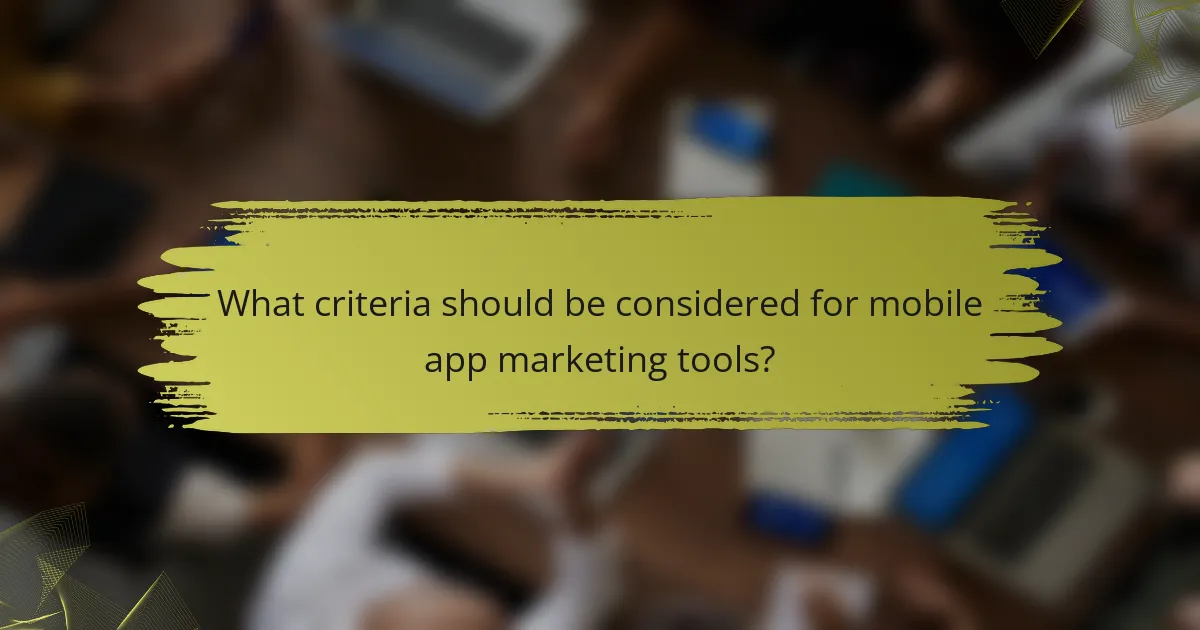
What criteria should be considered for mobile app marketing tools?
When selecting mobile app marketing tools, consider factors such as cost-effectiveness, user engagement features, analytics capabilities, and integration with existing platforms. These criteria help ensure that the tools align with your marketing goals and budget constraints.
Cost-effectiveness
Cost-effectiveness in mobile app marketing tools refers to the balance between the price of the tool and the value it provides. Evaluate whether the tool’s features justify its cost by comparing it to similar options in the market.
Look for tools that offer tiered pricing models, allowing you to choose a plan that fits your budget. Many platforms provide free trials or freemium versions, which can help you assess their value before committing financially.
Additionally, consider the potential return on investment (ROI). A tool that helps increase user acquisition or retention can ultimately save money and generate revenue, making it a worthwhile expenditure. Aim for tools that demonstrate clear metrics on user engagement and conversion rates to support your decision.
